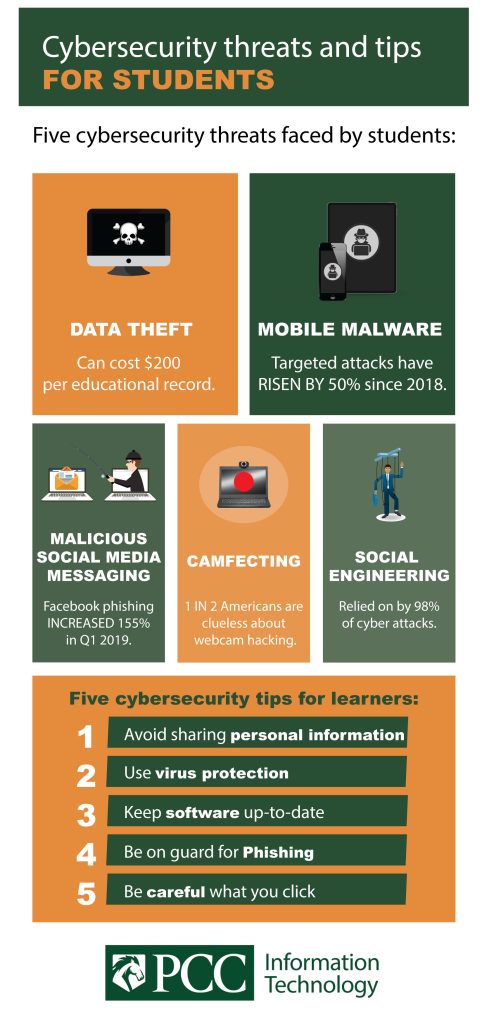
Cyber Threats for Students
To effectively prevent attacks, it is essential to develop a comprehensive understanding of the threats that students encounter today. Here are five types of attacks that demand awareness:
- Data Theft: Cyber attackers are well aware that students often lack proper knowledge of safeguarding personal and financial data used online, especially when it’s their first time. Exploiting this vulnerability, hackers can engage in identity theft, credit fraud, and other malicious activities.
- Mobile Malware: Attacks targeting mobile devices have increased by 50% since 2018, as revealed by researchers at Check Point. With more students transitioning from desktops or laptops to smartphones, the importance of prioritizing mobile security cannot be overstated.
- Malicious Social Media Messaging: Hackers take advantage of popular platforms like Facebook and WhatsApp to deceive victims with scams and redirect them to phishing websites, putting personal information at risk, as indicated in a study on cybersecurity threats amid the COVID-19 pandemic.
- Camfecting: Given the prevalence of desktop webcams or built-in cameras in students’ phones, tablets, and laptops, there’s a heightened risk of camfecting. This technique allows hackers to remotely access and control webcams, compromising privacy.
- Social Engineering: Social engineering scams rank among the top cybersecurity threats faced by higher education students, according to EducationDive. These attacks rely on manipulating users into divulging confidential information.
By understanding these potential dangers, it becomes possible to implement more effective measures to safeguard students from cyber threats.
Cybersecurity Tips for Students
In today’s digital landscape, cyber hackers are continuously devising new exploits and tactics to compromise users. To help safeguard yourself from potential threats, here are five essential cybersecurity best practices:
- Guard Personal Information: Exercise caution when sharing sensitive information online, such as school names, email addresses, home addresses, and telephone numbers. Limit the exposure of such details to trusted and verified platforms.
- Invest in Antivirus Protection: Protect all your devices, including desktops, laptops, and tablets, by installing reputable antivirus software with anti-phishing capabilities. Ensure it is set to update automatically and run regular virus scans, at least once a week.
- Keep Software Updated: Stay proactive in keeping your operating system, browser software, and apps up-to-date with the latest patches and security updates. Even new devices can have out-of-date software, which could expose you to risks.
- Beware of Phishing Attempts: Exercise caution when dealing with emails and attachments from unknown or untrusted sources. Even if you are expecting emails from group members or teachers, verify the sender’s authenticity before opening any attachments.
- Exercise Caution While Clicking: Avoid visiting unfamiliar websites or downloading software from untrusted sources. Such sites may host malware that can silently compromise your computer and put your data at risk.
By following these cybersecurity tips, you can enhance your online safety and protect yourself from potential cyber threats.
Want to learn more?
Watch this video to learn more about Cybersecurity
Additional Resources for Students
Contact
Information Technology
336-322-2300
support@piedmontcc.edu
Regular Hours
Monday through Thursday
8am to 5pm
Friday
8am to 4pm
Maintenance Windows:
Th 12a – 1a
Su 3a – 10a
